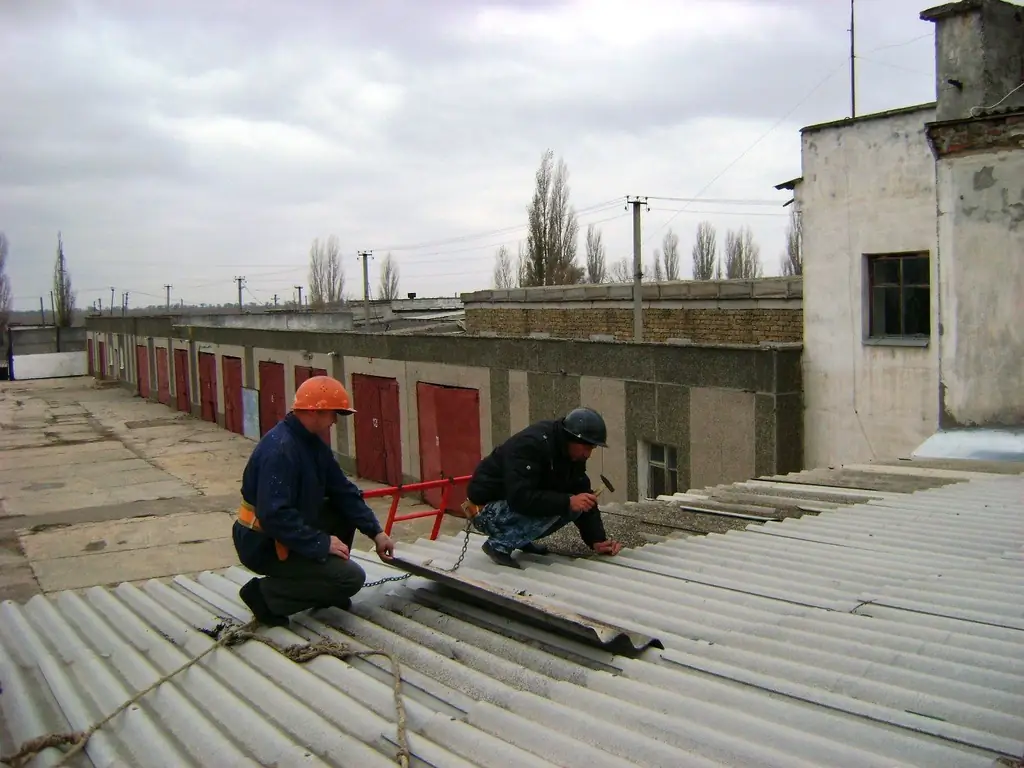
Table of contents:
- Author Bailey Albertson [email protected].
- Public 2023-12-17 12:53.
- Last modified 2025-06-01 07:32.
Slate roof repair

The service life of a slate roof largely depends on the quality of the slate itself. Manufacturers give a guarantee of no more than 5 years. In fact, the coating perfectly performs its functions for an average of 10-12 years. But if the owner of the building is interested in extending this period, and provides timely care, the roof will stand for 20-25 years. The main concern in this case is to prevent mechanical damage to the asbestos-cement plane. And if this does happen, promptly respond and eliminate the affected areas.
Content
-
1 The main defects and reasons for repairing a slate roof
- 1.1 Cracks and holes in slate
- 1.2 The slate roof is covered with moss
- 1.3 Blackening of slate
-
2 Slate cleaning methods
-
2.1 Mechanical roof cleaning
2.1.1 Video: cleaning slate with water under pressure
- 2.2 Chemical cleaning of slate roof
-
-
3 Ways to repair a slate roof
-
3.1 Repair of a slate roof with polyurea
3.1.1 Video: Unique Characteristics of Polyurea
- 3.2 How to update roof slate with cement
-
3.3 Blocking gaps with bitumen
3.3.1 Video: repairing damage to slate
-
3.4 Elimination of cracks with a mixture of asbestos, cement and PVA glue
3.4.1 Video: repair of slate with PVA glue with cement
- 3.5 Repair with butyl rubber tape
- 3.6 Repair with aluminum foil
- 3.7 Repairing cracks with waterproof adhesive
- 3.8 Application of drying oil with chalk
- 3.9 Tin plate
- 3.10 Epoxy with foam
- 3.11 Application of ready-made putties
-
-
4 How to replace roof slate
-
4.1 How to remove old slate from the roof
- 4.1.1 Video: how to remove an old roof
- 4.1.2 Video: how to lower the slate from the roof and not break
-
The main defects and reasons for repairing a slate roof
Authoritative sources (dictionaries of construction terminology) define slate as a generalized name for a group of roofing materials made from various waterproof compounds. Distinguish:
-
natural (or slate) slate obtained from rocks by splitting. Layered deposits of certain minerals are easily stratified into thin plates, which serve as roofing material. The German word schiefer actually means “slate”;

Slate slate Slate roofing requires a high level of skill
- fiber cement slate - sheets made of cement with the addition of cellulose, basalt fibers and fillers with mineral plasticizers. In our country it is often called "euro slate";
-
polycarbonate slate - a product made of polycarbonate, familiar to everyone in greenhouses. Once corrugated, the sheet is used to cover traditional pitched roofs;

Polycarbonate slate Polycarbonate is a very light material, but requires a reliable crate during installation
-
corrugated board is another popular analogue of slate, made of profiled sheet steel. Zinc and polymer spraying is applied over the stamped metal. As a result, the coating acquires anti-corrosion properties;

Corrugated board Profiled steel is characterized by high strength and resistance to mechanical damage
- polymer sand slate is one of the varieties of roofing material in which sand and polymer compounds are used instead of cement. It is known on the market under the name "ondulin". Imported analogue of domestic roofing felt;
- composite, or keramoplastic, slate. Manufactured using composite materials;
-
asbestos-cement slate - a sheet of wavy or flat shape, made by pressing from cement and sand with the addition of asbestos fibers.

Painted slate Asbestos-cement slate is painted in the factory
The most common type in private housing construction is asbestos-cement slate. Basically, it will be discussed further.
Slate has a reputation as a universal coating (used almost everywhere), which has strength and durability.
However, it also has weak points. There are many reasons due to which the solid structure collapses:
-
manufacturing defects. It cannot be determined at the time of purchase, which is what unscrupulous suppliers use. Since slate production is a complex technological process, flaws can occur at each stage. Here is just a short list of reasons leading to a decrease in the quality of the final product:
- non-compliance with the drying technology (according to GOST - at least 30 days);
- the use of low-quality ingredients in the preparation of the blank mixture;
- a change in the formulation towards a decrease in binding and reinforcing components;
- violation of the technological process (for example, a decrease in pressure during pressing or non-compliance with the thermal hardening regime);
- application of shortened asbestos fibers, reduced grade of cement, etc.
- violations during installation. Use of non-standard fasteners for installation: ordinary nails without rubber gaskets, large-diameter screws. Small holes in the attachment points cause the web to crack during seasonal expansion of the metal fastener. Any distortions and stresses of the material lead to its gradual destruction;
-
insufficient roof slope (less than 12 ° from the horizontal axis along the ridge). The rate of descent of water and snow slows down, and with a sharp onset of frost, everything turns into ice;

Determining the slope of the roof Roof slopes less than 12 ° can destroy the slate
- violations during transportation, laying and storage of slate. This also includes walking on the roof in hard shoes. Cracks will initially be invisible, but over time they will lead to leakage;
- shock loads from nearby trees, their falling branches. Even a small branch, broken by the wind and falling from a height of 15-20 m, can “injure” a fragile surface;
-
the appearance of mold, moss and lichen. Penetrating roots into microcracks, these plants gradually enlarge them. The flowing water completes the destruction process;

Moss on a slate roof Penetrating roots into microcracks on slate, moss gradually enlarges them
-
stagnant water around pipes and roof windows. Areas near stove chimneys are especially vulnerable - the accumulated moisture mixes with carbon monoxide and turns into a potent acid. In addition, you should monitor the drainage of condensate from the ventilation shafts, clean the drain gutters;

Gutter Clogged gutter leads to the formation of ice on the slate
- destruction from time to time. Solar radiation and climatic phenomena sooner or later lead to a weakening of the strength of the slate. In theory, its service life is limited to 10-12 years;
-
separately it should be said about the snow. Slate roofing is not as smooth as corrugated board or folded metal roofing. When heated (from the heat of the house or the sun), the snow that lingers on melts and flows into the narrowest cracks, up to the supporting rafters. Melt water is very active chemically, and when it gets on the wood it causes rotting. That is why it is necessary to strictly adhere to the laying technology - to withstand the overlap of the slate horizontally in one or two waves, vertically - 20-25 cm.

Slate laying technology Methods for laying slate coverings involve displacement both vertically and horizontally
If any of the above factors becomes "chronic", visual evidence of the destruction process appears on the roof.
Cracks and holes in the slate
They are mainly the result of mechanical damage. They must be eliminated as soon as possible, since such defects lead to the open penetration of water into the attic space.
Waterproofing can be a short-term salvation, if it was provided for during construction. If not, then the defeat of wooden beams by rot is inevitable. And not only load-bearing, but also the lower attic floors.

The formation of cracks and holes in the slate leads to the penetration of water into the attic
Reasons for the appearance of holes in the slate coating:
- bricks falling from a crumbling chimney;
- hail and strong winds, as a result of which debris and small objects fly onto the roof;
- incorrect fastening of the slate - a small hole forms around the nail or screw, which gradually crumbles and grows into a full hole. The slate loses its fastening rigidity and can be blown off the roof by the wind. This once again reminds of the need for rubber seals under the head of the nails.
Cracks are the result of sheet distortions. Most often, they are formed along the wave with improper pressing against the roof plane. Moreover, at first they may be imperceptible and clearly appear after a few years.

Cracks in the slate appear as a result of distortions of the sheet during installation
The slate roof is covered with moss
Mosses and molds are propagated by spores. At the time of flowering, they are carried through the air for many kilometers. If there are "secluded" places on the roof (gutters, valleys, cornices, etc.) clogged with leaves, then the spores will settle there, and after a while the slate surface will be covered with mossy growth.
Some lovers of natural landscapes like this picture very much, but one should not forget that moss retains moisture very well, and its roots can even break the structure of a stone. It is necessary to eliminate the phenomenon in the bud, otherwise after 2-3 years the entire roof covering will have to be changed.

Regular cleaning of slate from parasitic vegetation is a prerequisite for long-term operation
Blackening of the slate
Blackening is the last stage of decomposition of the structure of an asbestos-cement coating. Some believe that pigmentation occurs under the influence of a fungus, others believe that this phenomenon is accompanied by a change in the cement ligament. Usually at this stage, the slate becomes brittle, exfoliates and crumbles.

If the slate turns black, the roofing sheet must be replaced as soon as possible.
Whatever it was, but blackening is the last "bell" warning the owner about the need to replace the roofing sheet. Temporary measures - cleaning and painting - can postpone the terms by 2-3 years, but after that the roof will still have to be rebuilt.
Slate cleaning methods
Since slate has a rough surface, it tends to trap various organic debris: foliage, small branches, etc. As a result, the process of decay may begin, which will lead to the formation of mold and mildew. Therefore, the roof must be periodically cleaned from debris, as well as from growths of moss, which can destroy the material.
Mechanical roof cleaning
This is the simplest roof maintenance operation. Does not require any qualifications and sophisticated equipment. It consists in regularly cleaning the roof from stagnant debris: fallen leaves, chips, sand and other things. They, as a rule, accumulate near drains, in valleys and on adjoining cornices.
A regular broom or brush is used for cleaning. In rare cases, a scapula is used. It is necessary to remove the dirt carefully, keeping in mind that the accumulation of "silt" is a potential place for roof rotting. Sometimes pressurized water is used (a Karcher pump or water hoses connected to the water supply system). This makes the task somewhat easier, but you need to be careful, because wet slate is very slippery.

You can use water to clean the roof only after making sure that the coating is intact.

Metal bristles will clean the roof surface well in difficult places
After cleaning, it will not be superfluous to carefully inspect the entire plane. If small cracks or chips are found, they need to be repaired. Ordinary exterior paint (alkyd or polyamide enamel) is sometimes used. But you should know that this method is good as a temporary measure for one season, no more. The same applies to drying oil.
Video: cleaning slate with water under pressure
Chemical cleaning of a slate roof
To eliminate mosses and molds from the roof, not only mechanical methods are used, but also special chemical reagents. The traditional way is to sprinkle the surface with a hydrochloric acid solution. But cooking it at home is quite problematic, and even unsafe. A new generation of cleaning products is available on the market to destroy all vegetation on slate. You need to work with them in compliance with personal safety measures, use rubber gloves and a respirator.

Special roof and facade cleaners help to clean the roof of unwanted vegetation
To evenly spray the solution over the surface, it is recommended to move along the prepared ladders. More attention is paid to the north side of the roof, as this is where moss colonies are more likely to form.
Slate roof repair methods
Moving on to the fun part. How to save a house from trouble. After all, a leaking roof is a real threat to the entire structure. Only a timely response to any damage will save the slate from further destruction.
Repair of a slate roof with polyurea
Polyurea is a two-component substance made up of resin and isocyanate. Other names: polyurea and polyuria. When covering the roof with this substance, an elastic multilayer film is formed, which withstands mechanical damage and is insensitive to temperature changes.
It is used for waterproofing in capital construction: hydrophobic treatment of foundations, plinths, the bottom of artificial reservoirs, reservoirs, and including roofs. Features of polyurea:
- harmless to humans;
- hardens quickly (10-15 seconds after application);
- not flammable;
- resistant to high and low temperatures.

To cover the roof with polyurea, production equipment is required, therefore, the drug is rarely used in private housing construction
However, in private housing construction, the drug is rarely used. This is due to the sophisticated equipment required to spray. To obtain a substance, you need to mix about two dozen ingredients. Perhaps, in the near future, small cans for household use, similar to polyurethane foam, will appear on sale. But so far, polyuria is available for use only in large industrial facilities.
Video: the unique characteristics of polyurea
How to update roof slate with cement
Cracks in the slate can be repaired with cement:
- A standard building mixture is being prepared: one part of cement and two parts of fine sand.
- After thoroughly mixing everything with water, the crack is closed along its entire length.
- After drying, it is cleaned of sagging, then paint or drying oil is applied.

To repair slate, you will need a standard cement mixture: one part of cement and two parts of fine sand
Blocking cracks with bitumen
Repair with bituminous mastic is as follows:
- To prepare the patch, a fire is made with two bricks on the sides.
- A piece of bitumen is immersed in a metal container (old kettle, saucepan, etc.).
- The container is set on fire until the bitumen is completely transformed into a liquid state.
- If work is carried out in frosty weather, up to 10% of used engine oil is added to the bitumen. This will give it more fluidity and allow it to fall into the very depths of the cracks.
- To further strengthen the strength of the patch, a construction mesh is used - serpyanka. After applying the first layer, a paint net is glued to it and covered with another layer of molten mortar.
- Smear the top layer until the serpyanka completely disappears from sight.

With the help of bitumen, not only cracks are processed, but also the joints of slate sheets
Lack of bitumen putty - the material is suitable for only a few climatic cycles. Then the procedure will have to be repeated or changed as a whole.
Video: repairing damage to slate
Elimination of cracks with a mixture of asbestos, cement and PVA glue
Each ingredient is commercially available. The mixture is easy to make yourself. The proportion of the composition is as follows:
- 3 volumetric parts of asbestos;
- 2 volumetric parts of cement (grade is desirable from 400 and above);
- PVA glue solution with water in a ratio of 1: 1.

Surface treatment of the finished patch is carried out with PVA glue diluted with water in a ratio of 1: 3
The paste is applied to dry, pre-cleaned slate: the roof is covered with the first layer of the mixture, then treated with a solution of PVA and water (in a ratio of 1: 3), then two more layers of the mixture. After drying, it can be treated with several layers of PVA glue.
Video: repair of slate with PVA glue with cement
Repair with butyl rubber tape
This tape is sold in many hardware stores and home improvement markets. Patches are made from it, cut to the desired size. The procedure is simple:
- The repaired section of the slate is degreased with a solvent or pure gasoline.
- The protective film is removed from the tape.
- The patch is glued to the slate.
Then you can give the tape the desired color using paint.

The use of butyl rubber tape requires preliminary degreasing of the slate with gasoline
There are ready-made butyl patches for roof repairs on sale.
Repair with aluminum foil
The process is as follows:
- The patch is made in the required sizes.
- Old fasteners are removed, which will interfere with the installation of the foil. For the same purpose, the edges of the plate are rounded off.
- The foil is wound under the top sheet and secured with flat head screws and a rubber gasket.
- On top of the aluminum, paint of a suitable color is applied.

Aluminum foil will protect cracked slate well from precipitation
Removing cracks with waterproof glue
The patch making procedure is as follows:
- The place of repair is cleaned and washed out, the gap or hole is treated with a metal brush.
-
A dense fabric is glued to the dried surface. The dimensions of the fabric are selected so that it overlaps the defect by 5-7 cm along the entire perimeter. The patch is pre-impregnated with waterproof glue.

Waterproof glue It is recommended to use rubber gloves when working with waterproof glue
- Another layer of glue is applied to the patch.
- If there is access to the underside of the slate (from the attic side), the same procedure is repeated from the inside.
- It is recommended to paint after drying.
Application of drying oil with chalk
Probably the most tried and tested popular way to eliminate leaks. The crack is cleaned, washed, dried. Chalk is added to the drying oil until a creamy mass is formed. It is applied with a stiff brush or spatula. After drying, it is covered with a finishing layer of linseed oil.

To repair cracks in slate, you can use drying oil mixed with chalk to a creamy consistency.
Tin patch
The algorithm is not complicated, but it requires accuracy. It can be used to eliminate large holes and even transverse cracks.
- A patch is made of tin of the required size.
- It is laid on the affected area, repeating the wavy shape of the slate.
- Fastened with self-tapping screws along the perimeter and in the depressions.
There is another option, suitable for small through holes:
- The tin is rolled into a tube and inserted into the slate hole.
- Next, a bolt with a rubber gasket is inserted into it and tightened with a nut on the other side. The result is something like a sealed rivet.
Epoxy resin with foam
A simple method of dealing with damage, developed by craftsmen. You will need polyurethane foam, epoxy resin with hardener and a solvent.

When preparing the mixture, you must adhere to the proportions indicated in the instructions.
- All accumulated dust from the split sheet of slate is washed out and blown out.
- The crack is filled with polyurethane foam through the fine nozzle of the gun.
- When the foam starts to dry out (does not stick to your hands), the top layer is compacted into the gap. This will seal its porous structure.
- After the polyurethane has completely hardened, the patch is covered with an even layer of prepared resin.
Application of ready-made putties
If there is a ready-made putty from the store, you must first of all read the instructions for use. Well suited for roof repairs, putties such as “liquid rubber”. They are moisture-repellent, flexible and deeply penetrate materials. The procedure is usually standard:
- Cleaning and degreasing the problem area.
- Initial priming with a weak putty solution (this point is optional, but desirable).
- Covering the damaged area with putty. It is carried out with a rubber or metal spatula.
- After drying, reapply the insulating layer.
Works are carried out in dry weather. Some putties do not tolerate wetting.

Roof repairs can be done with rubber paint or risoline
Reinforcement of the patch with glass cloth or painting net is allowed between the first and second layer.
How to replace roof slate
Replacing the slate is necessary when it is impossible to repair the sheet by other available methods. The sequence of work is to dismantle the old slate and replace it with a new one.
If it is necessary to replace only one or several sheets, it is necessary to loosen the fastening of the adjacent ones on three sides (except for the bottom). Since the overlap with correct assembly can be up to 20 cm, riving boards should be prepared. A badly destroyed sheet of slate, which can no longer be restored, can be split and discarded for the convenience of disposal.
How to remove old slate from a roof
This is sometimes a tricky operation, especially with old coatings. Under mechanical stress, the slate can crack and break. Therefore, you must use a pry bar with a wooden backing to pull the nails out.

Wooden backing keeps the slate sheet intact when pulling out nails
Screws are easier to unscrew, this is their mounting advantage. Dismantling is carried out from the bottom up, the dismantling sequence is determined by the laying technology.

Work with slate is carried out only with the use of personal safety equipment
If old and rusted nails do not respond well, you can use a grinder with a disc for metal. Carefully, without damaging the cement surface, the nail head is cut off. If there are residues of rubber seals on the nail, they must be removed first. After that, with an upward movement, the slate can be released from its fixation and lowered to the ground.
Video: how to remove an old roof
In addition to detaching the sheet, it must be carefully lowered from a height, since the material is rather fragile. Here you cannot do without the help of a partner or special devices. If the height of the building allows, you can use the boards, building them "sled". And so that when it hits the ground, the sheet does not break, thread a safety rope through one of the holes.
Video: how to lower slate from the roof and not break
Having mastered simple ways to repair damage on a roof covered with slate, you can maintain the roof in working order for a long time. Facts are known when slate is used for 50 years or more. The only thing that should not be forgotten when carrying out repairs is the safety rules. Work at heights is classified as hazardous work. It is advisable to use a safety belt and special shoes. And be sure to ask relatives or neighbors to be present during the repair of the roof. It is forbidden to repair the roof alone for safety reasons.
Recommended:
Do-it-yourself Drill Repair: How To Connect A Button, Replace Brushes, Check The Rotor, Repair The Anchor, Instructions With Photos And Videos
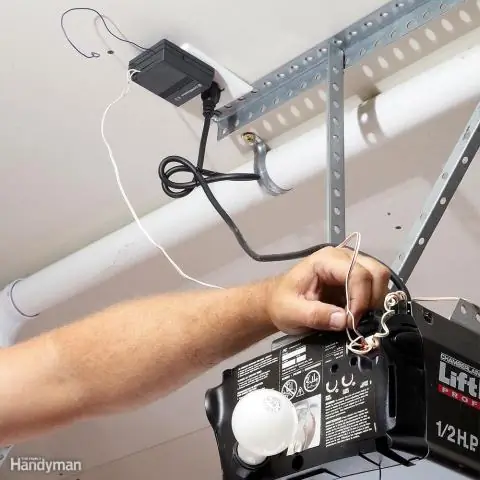
Electric drill device. How to properly disassemble and assemble a drill. Possible malfunctions and remedies. Required tool
How To Make A Roof On A Balcony, Including The Features Of Its Device, As Well As How To Repair A Roof
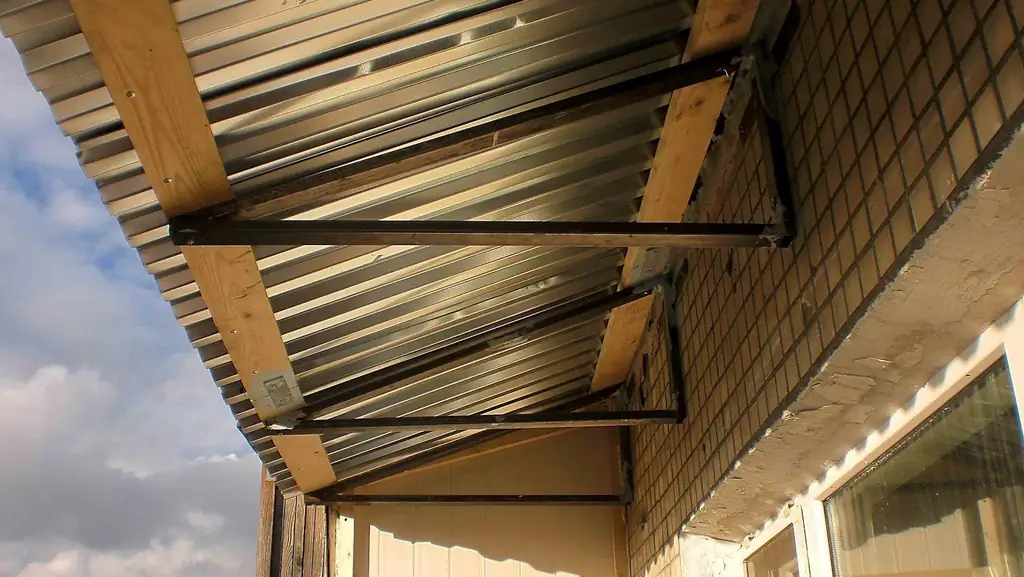
How the roof of the balcony is arranged and what materials are needed for its manufacture. The procedure for installing the roof of the balcony and the technology for eliminating breakdowns
Slate Roof, Including Features Of Its Design And Operation, As Well As Installation Errors
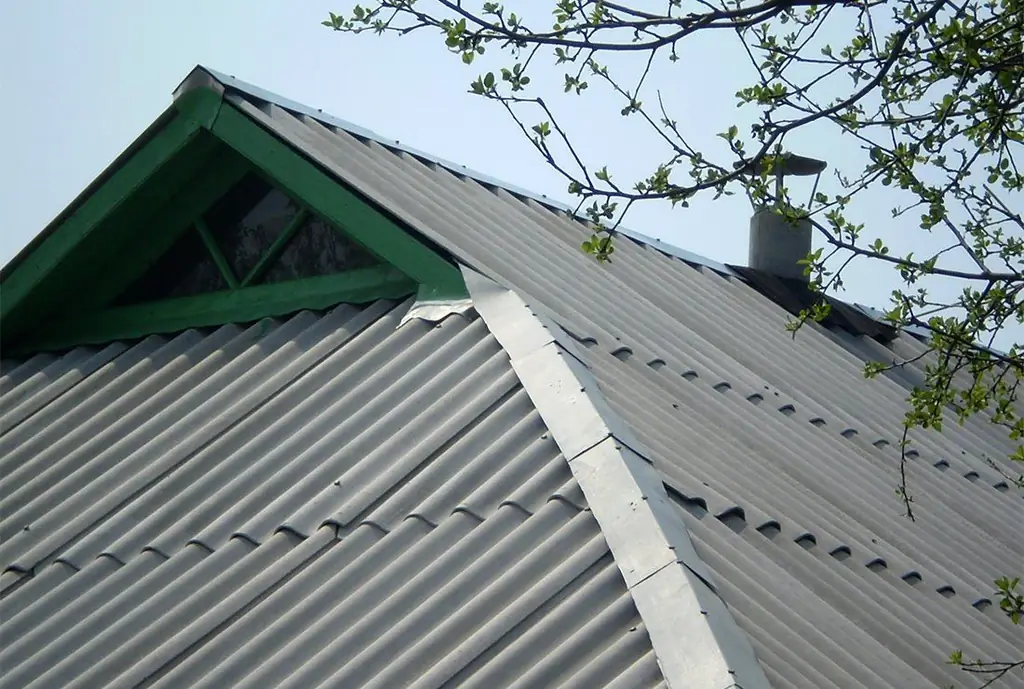
Features of the slate roof. Slate roof device. How to make a slate roof with your own hands: step by step instructions. Operating rules
Installation Of Seam Roofing, Including With Your Own Hands, The Main Stages Of Carrying Out, As Well As How To Avoid Major Mistakes

What is a seam roof. What tools and material are needed for installation. Coating laying technology, stages of installation. What mistakes can be made
Slate Roofing, Including The Features Of Its Design And Operation, Repair, As Well As How To Avoid Mistakes During Installation
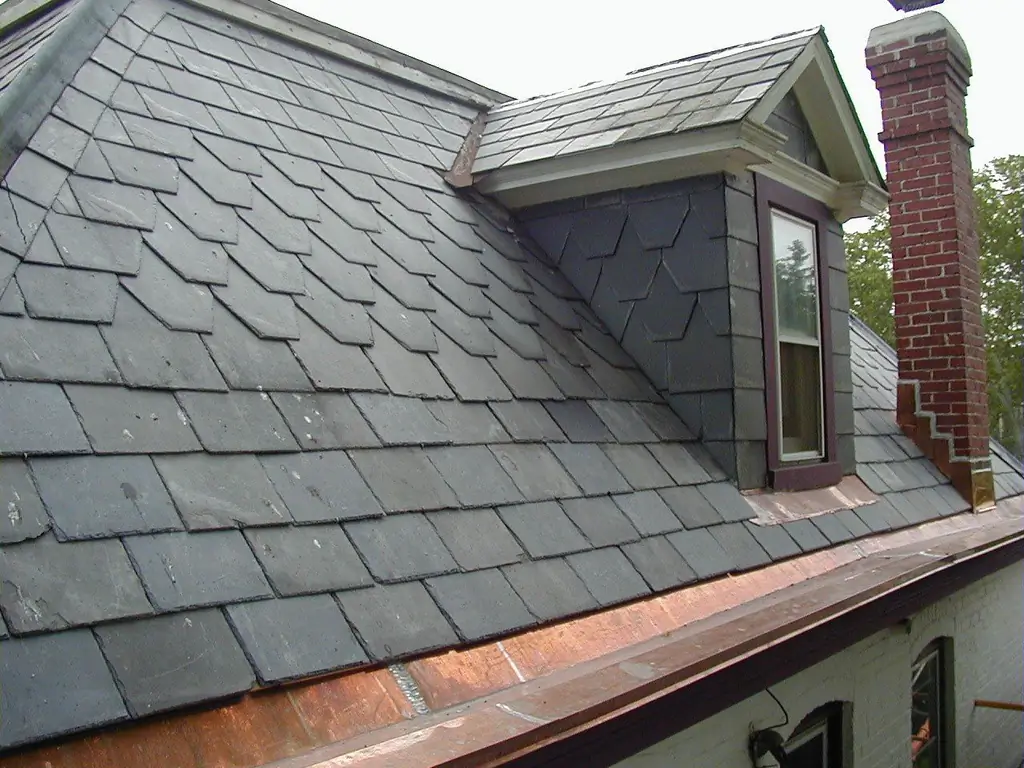
Features of a slate roof. What installation method to choose and how to choose the right material. Maintenance, repair, service life, how to avoid mistakes during installation
